Top Performer
SVTP discusses the Shelby GT350 with Ford’s Global Performance Vehicle Chief Engineer
By Steve Turner
Photos by Stacy Stangz and courtesy of Ford Motor Company
If you are a fan of Ford performance, it’s highly likely that the new Shelby GT350 has your engine warmed up. Obviously, we are tantalized by this high-revving, hot-handling version based on the benchmark S550 platform. So much so that we trekked out the official unveiling at Shelby American to see it revealed live. Afterward we made it to the Los Angeles International Auto Show where we had a chance to sit down with Ford’s Global Performance Vehicle Chief Engineer, Jamal Hameedi, and discuss his latest progeny.

If you have followed the history of Ford SVT, you know that Jamal has risen through the ranks of Ford’s performance division after a successful run with the company’s Rough Rider off-road racing program, which raced in SCORE Trophy Truck. He has had a hand in star vehicles like the Ford GT and he spearheaded the SVT Raptor and the last-generation Shelby GT500. The latest performance vehicle born under his purview is the new Shelby GT350, which is all about agility.
“Everything we did was about vehicle dynamics, all the way down to the engine choice,†Jamal told SID297 in our video interview. “We wanted the lightest possible engine we could find that still made decent power. Power density was really important.â€
That power is courtesy of Ford’s first production flat-plane crank engine, which will feature the longest stroke of any FPC engine to date. It is a high-tech engine loosely based on the existing 5.0-liter engine, and it is ready to rev to an 8,200-rpm redline thanks to features like pistons that are lighter than those in the FPC engine that powers Ferrari’s 458.
“The idea was there from the beginning, but we had to do a ton of simulation and engineering to make sure that we could pull it off,†Jamal explained. “It’s got the same Coyote architecture—bore spacing, all of that—but for all intents and purposes, it’s an all-new engine: new intake, new heads, new block, new crank, new rods, new pistons. It’s an all-new engine.â€

While the GT350’s 500-horsepower, 5.2-liter engine is certainly exciting, there is more to this car than power. It is built for balanced performance.
“It’s really been about throwing the kitchen sink at the car to improve the overall vehicle dynamics,†Jamal said. “That’s what a GT350 is all about.â€
Part of improving the vehicle dynamics was a give and take when it came to reducing weight, but maintaining the necessary brawn to handle the engine output.
“Unless you are going to build a carbon-fiber-tubbed car there aren’t a lot of weight savings silver bullets,†he said. “In order to get weight out or to offset weight add (from bigger brakes, wheels, and tires), it’s really about attention to detail and shaving a kilogram or a pound here and half a kilogram there. So we tried to have that philosophy on every new part we touched.â€
That meant backing the engine with a lighter Tremec 3160 six-speed manual transmission, but retaining a two-piece steel driveshaft.
“The transmission, for sure, isn’t as stout as a 6060. This has got a dual-mass flywheel, which does ease the shock loads going into the trans,†Jamal explained. “We never even thought of putting a 6060 in because they are way too heavy.â€

“We needed the stiffest driveshaft we could get, he added. “We looked at a carbon-fiber driveshaft and we couldn’t get it stiff enough, so we went with the two-piece steel.â€
Aside from its obvious mechanical advancements, the GT350 is also a technological tour de force, which looks to democratize technology that is far more common on European exotics.
“We now have five drive modes. We call them integrated driver controls. There are five settings that control ABS, traction control, exhaust valves, powertrain settings, and the damper settings. There’s a lot of adjustability built into the system.â€

Key to the application of these driver modes is the new MagneRide suspension, which can adjust the dampers in as little as 10 miliseconds. It is becoming a more common suspension technology, but it is another tool in the Ford performance toolbox.
“It’s cool. You tune the thing with a laptop instead of changing shims,†Jamal enthused. “It’s really the equivalent of going from a carburetor, with jets and everything, to a fuel-injection system.â€
Like the dampers, the exhaust system also falls under the sway of the driver modes. Depending on what button you push, the exhaust will flow through to mufflers or detour out through straight pipes.
“There’s a couple of electric valves in there and when the valves open, it’s a straight exhaust, basically. The valve is controlled through all the drive modes. If you are Normal the valve is usually closed, but when you are in Track mode it is usually open. …Plus there is a button in the car that lets you defeat it. So if you want instant, flat-plane music, you just hit the button and there you have it.â€
Suffice it to say, the more we hear about the new Shelby GT350, the more excited we get to slide behind the wheel and experience it for ourselves.



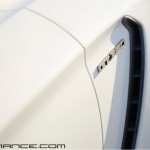
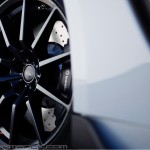


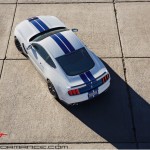








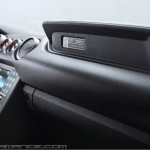
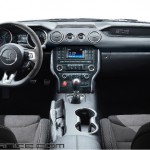






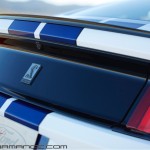
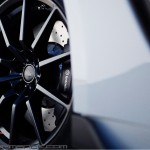

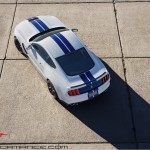
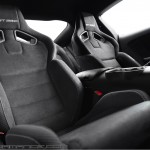

With that compromise in mind one thing is for certain…this new gearbox better shift well. Hopefully the shifter was given more attention than even that of the regular Mustang GT.
The use of a two-piece steel driveshaft is a bit of a letdown. I hope we can get more detail as time passes because to be quite hones, I’m struggling with Jamal’s comment that the engineers couldn’t get a CF shaft that was “stiff enough.”
From Tom Wilson’s article of a couple of years ago we learned that the 662 hp, 200+ mph car, was using a CF shaft. Why?
Finally! Some interesting commentary for sure. Especially when Jamal stated that they never even thought about putting in a TR6060 just because “they are way too heavy.” So ultimate torque capacity was sacrificed due to weight considerations. No built-in over capacity. With that compromise in mind one thing is for certain…this new gearbox better shift well. Hopefully the shifter was given more attention than even that of the regular Mustang GT.
The use of a two-piece steel driveshaft is a bit of a letdown. I hope we can get more detail as time passes because to be quite hones, I’m struggling with Jamal’s comment that the engineers couldn’t get a CF shaft that was “stiff enough.”
Why?
Another interesting tidbit from that article.
Saves weight, has the ability to transmit more torque, and has the potential to eliminate friction when in comparison to a two-piece steel shaft with a center support bearing. In other words, a CF shaft represents everything Ford was looking to accomplish with the GT350. Yet we now have commentary that Ford couldn’t get one “stiff enough” for use behind a similar wheel base vehicle that has less horsepower/torque, and undoubtedly a lower top speed.
Suddenly, cost rears its head but not openly. Especially given the context Jamal provided in that same article.
What is most ironic is that the pre-production GT350 used for the reveal in Las Vegas, looked to be sporting a CF shaft.
Good points Tob. Thanks for your insight and time!
Good stuff. I would have asked about the 5.2s official red line!
I wonder if it was for more NVH reasons. CF shafts are plenty strong.
Jamal’s comments about cutting weight wherever they can only to reintroduce the two piece ds in the car didn’t add up to me either. I have a hard time believing that cf isn’t “stiff enough”. It appears the bean counters got ahold of this. The aftermarket will correct it, but it should have come from the factory with it already.
I watched it twice, and he danced around some of those answers. I know he was BS’ing some of that, so let’s wait and see.
Nice job on the interview.
A couple of more hard ball questions I would have asked:
1. Carbon Rev has announced that they have inked a deal with a MAJOR manufacturer to supply CF wheels on a production car. Are they going on the GT350 as on option?
2. It would seem obvious that a Laguna Seca type version of the GT350 is in order. Any plans for a GT350R?
3. Were CCB’s considered?
4. What consideration was given to rear brake ducting?
I also agree about the CF driveshaft explanation. I’m sure he’s telling the truth but maybe only half of it. 😉
https://www.youtube.com/watch?v=hjErH4_1fks
http://youtu.be/kaoq8Mc4xxw?t=11m2s
Just an example of what BMW is using CF for here.
I’ll stop. So Ford couldn’t get a CF shaft that was “stiff enough?” Come on. I would have been less disappointed with a response like “when we weighed the overall benefit of using a CF shaft in this specific application we found that a two-piece steel shaft was able to meet our performance goals and come in at a much lower cost which is in keeping with our philosophy about producing a vehicle that provided the best bang for the buck.”
Thinking through the ’15 transmission/driveshaft philosophy (which may or may not have influence on the GT350 in this case), I wondered about the use of a “Guibo” joint and what role it played in conjunction with a CF shaft. I wrote Kelly at BMR this morning looking for a photo of his joint as I knew had added an aluminum driveshaft to his 2015. Of note, and as Kelly put it “that guibo is only on the Performance Pack Manual trans car…..the auto GT does not have that joint.” Here’s a photo of the joint which Ford is using between the front of the driveshaft and the fixed flange at the rear of the transmission. Many aftermarket shaft manufacturers are eliminating this joint when adding their shafts. It is assumed there would be an NVH increase.
Any, I’m thinking that the use of a CF shaft in this application would indeed negate the use of a guibo joint as the material properties in the CF shaft have an inherent damping capacity as well. So what could be the issue? The rear subframe is isolated (and hence the axle gear case) from the body via bushings (which are presumably stiffer on the GT350). The transmission has been reworked for this application. But the engine needed a lot of attention due to the FPC design. I’m just not seeing a “stiffness” issue that couldn’t have been overcome (putting cost aside for the moment which may not be entirely fair). Was Jamal hinting at some sort of “delay” at high rpm when shifting due to the CF’s ability to twist and recover? Was the “feel” of it just not right?
I hope he can elaborate.